TOYOTA 86 2022 Owners Manual
Manufacturer: TOYOTA, Model Year: 2022, Model line: 86, Model: TOYOTA 86 2022Pages: 449, PDF Size: 8.5 MB
Page 371 of 449
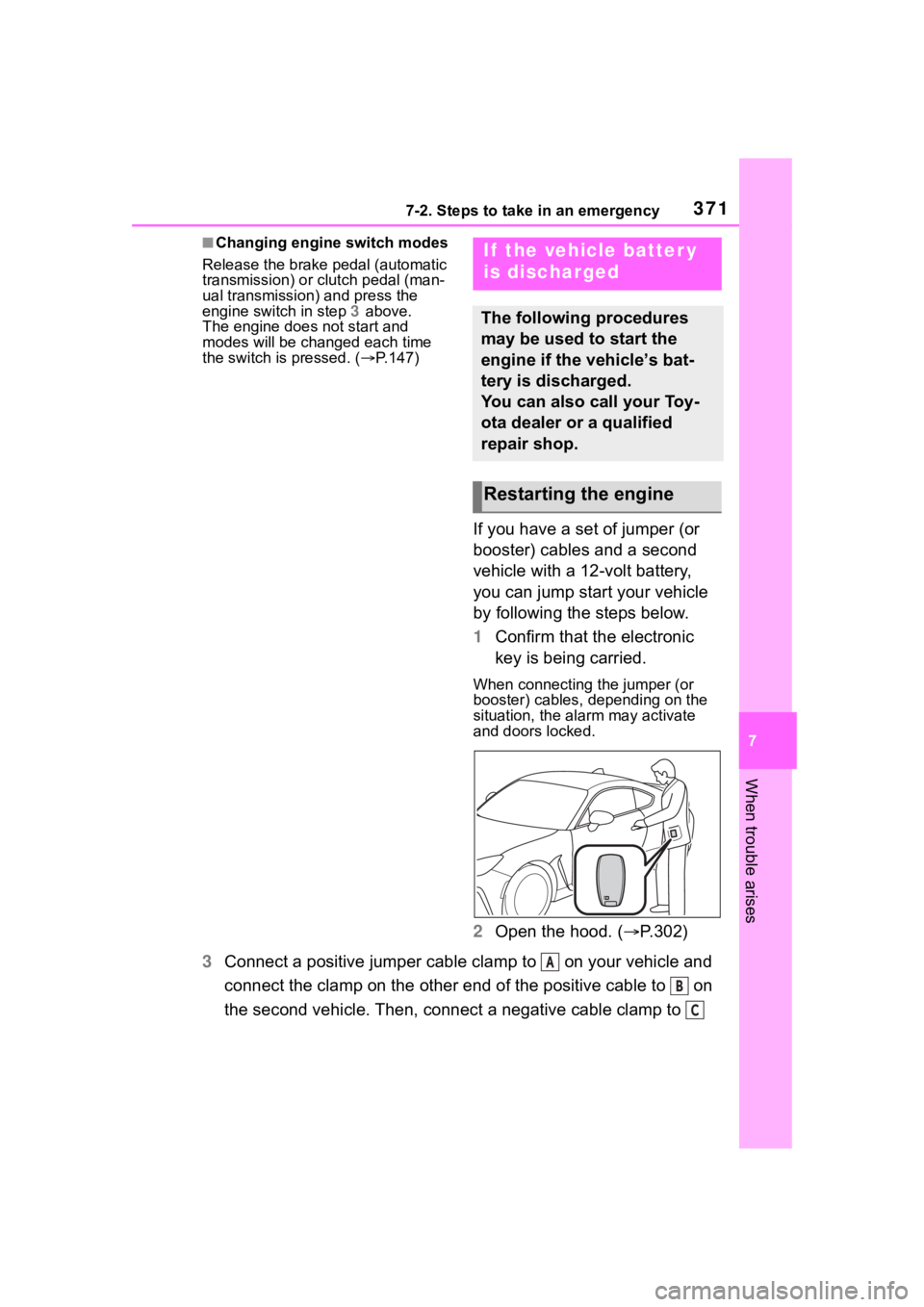
3717-2. Steps to take in an emergency
7
When trouble arises
■Changing engine switch modes
Release the brake pedal (automatic
transmission) or clutch pedal (man-
ual transmission) and press the
engine switch in step 3 above.
The engine does not start and
modes will be cha nged each time
the switch is pressed. ( P.147)
If you have a set of jumper (or
booster) cables and a second
vehicle with a 12-volt battery,
you can jump start your vehicle
by following the steps below.
1Confirm that the electronic
key is being carried.
When connecting the jumper (or
booster) cables, depending on the
situation, the alarm may activate
and doors locked.
2Open the hood. ( P.302)
3 Connect a positive jumper cable clamp to on your vehicle and
connect the clamp on the other end of the positive cable to on
the second vehicle. Then, connect a negative cable clamp to
If the vehicle batter y
is discharged
The following procedures
may be used to start the
engine if the vehicle’s bat-
tery is discharged.
You can also call your Toy-
ota dealer or a qualified
repair shop.
Restarting the engine
A
B
C
Page 372 of 449
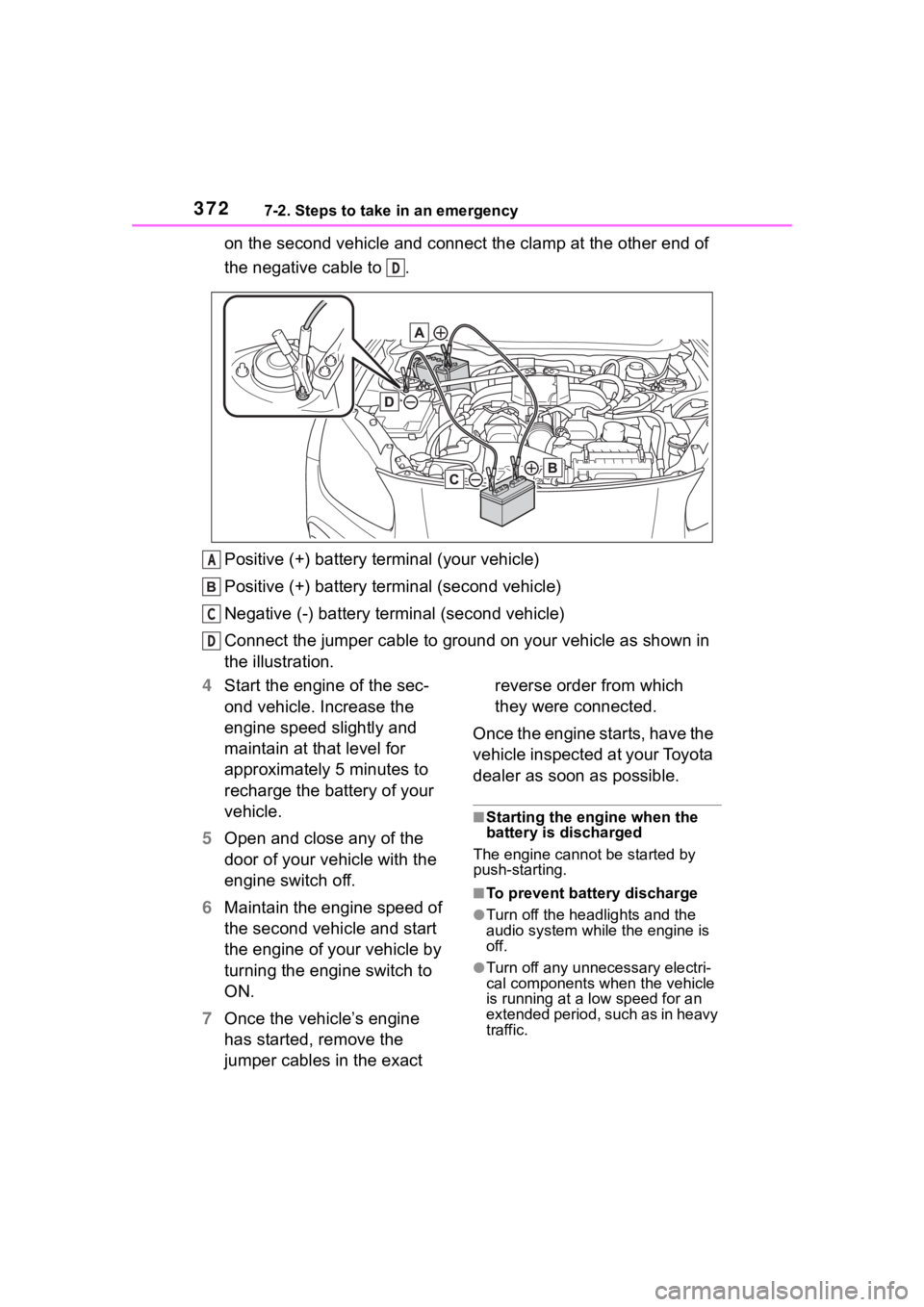
3727-2. Steps to take in an emergency
on the second vehicle and connect the clamp at the other end of
the negative cable to .
Positive (+) battery terminal (your vehicle)
Positive (+) battery terminal (second vehicle)
Negative (-) battery term inal (second vehicle)
Connect the jumper cable to ground on your vehicle as shown in
the illustration.
4 Start the engine of the sec-
ond vehicle. Increase the
engine speed slightly and
maintain at that level for
approximately 5 minutes to
recharge the battery of your
vehicle.
5 Open and close any of the
door of your vehicle with the
engine switch off.
6 Maintain the engine speed of
the second vehicle and start
the engine of your vehicle by
turning the engine switch to
ON.
7 Once the vehicle’s engine
has started, remove the
jumper cables in the exact reverse order from which
they were connected.
Once the engine starts, have the
vehicle inspected at your Toyota
dealer as soon as possible.
■Starting the engine when the
battery is discharged
The engine cannot be started by
push-starting.
■To prevent bat tery discharge
●Turn off the headlights and the
audio system while the engine is
off.
●Turn off any unnecessary electri-
cal components when the vehicle
is running at a low speed for an
extended period, such as in heavy
traffic.
D
A
C
D
Page 373 of 449
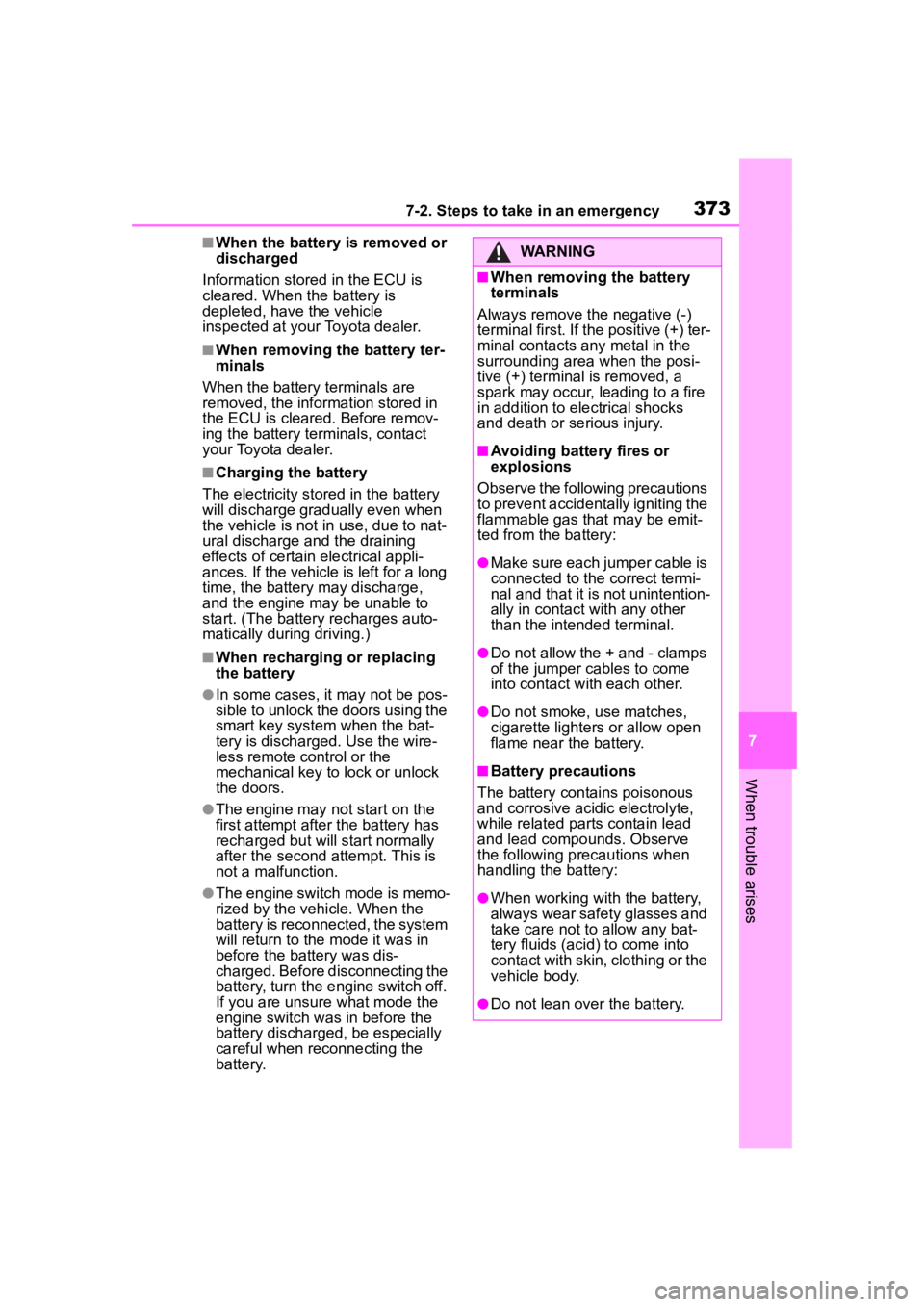
3737-2. Steps to take in an emergency
7
When trouble arises
■When the battery is removed or
discharged
Information stored in the ECU is
cleared. When the battery is
depleted, have the vehicle
inspected at your Toyota dealer.
■When removing the battery ter-
minals
When the battery terminals are
removed, the information stored in
the ECU is cleared . Before remov-
ing the battery terminals, contact
your Toyota dealer.
■Charging the battery
The electricity stor ed in the battery
will discharge gradu ally even when
the vehicle is not in use, due to nat-
ural discharge and the draining
effects of certain electrical appli-
ances. If the vehicle is left for a long
time, the battery may discharge,
and the engine ma y be unable to
start. (The battery recharges auto-
matically during driving.)
■When recharging or replacing
the battery
●In some cases, it may not be pos-
sible to unlock the doors using the
smart key system when the bat-
tery is discharged. Use the wire-
less remote control or the
mechanical key to lock or unlock
the doors.
●The engine may not start on the
first attempt after the battery has
recharged but will start normally
after the second attempt. This is
not a malfunction.
●The engine switch mode is memo-
rized by the vehicle. When the
battery is reconnected, the system
will return to the mode it was in
before the battery was dis-
charged. Before disconnecting the
battery, turn the engine switch off.
If you are unsure what mode the
engine switch was in before the
battery discharged, be especially
careful when reconnecting the
battery.
WARNING
■When removing the battery
terminals
Always remove the negative (-)
terminal first. If the positive (+) ter-
minal contacts any metal in the
surrounding area when the posi-
tive (+) terminal is removed, a
spark may occur, leading to a fire
in addition to ele ctrical shocks
and death or serious injury.
■Avoiding battery fires or
explosions
Observe the following precautions
to prevent accidentally igniting the
flammable gas that may be emit-
ted from the battery:
●Make sure each jumper cable is
connected to the correct termi-
nal and that it is not unintention-
ally in contact with any other
than the intended terminal.
●Do not allow the + and - clamps
of the jumper cables to come
into contact with each other.
●Do not smoke, use matches,
cigarette lighter s or allow open
flame near the battery.
■Battery precautions
The battery contains poisonous
and corrosive acidic electrolyte,
while related parts contain lead
and lead compounds. Observe
the following precautions when
handling the battery:
●When working with the battery,
always wear safety glasses and
take care not to allow any bat-
tery fluids (acid) to come into
contact with skin, clothing or the
vehicle body.
●Do not lean over the battery.
Page 374 of 449
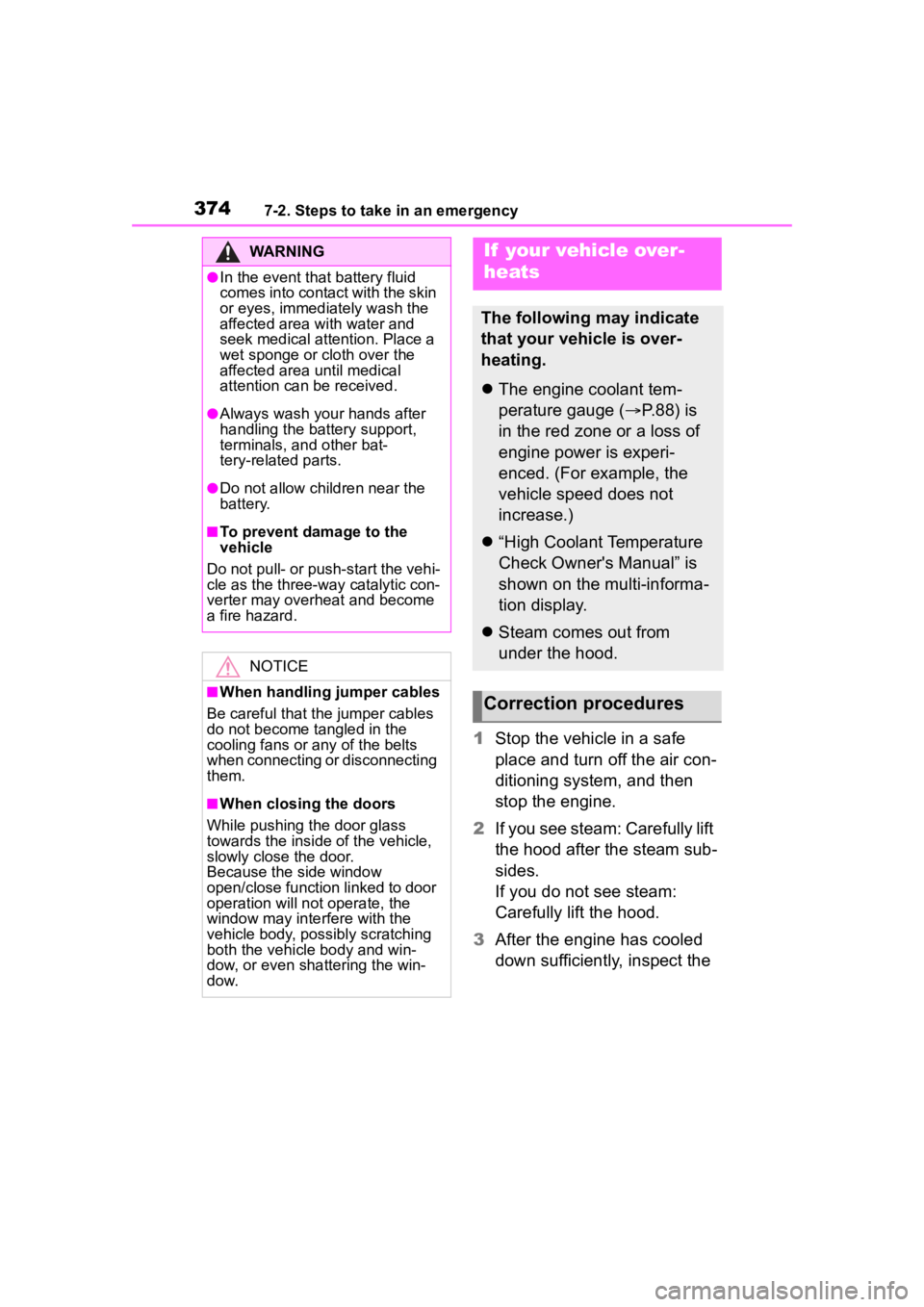
3747-2. Steps to take in an emergency
1Stop the vehicle in a safe
place and turn off the air con-
ditioning system, and then
stop the engine.
2 If you see steam: Carefully lift
the hood after the steam sub-
sides.
If you do not see steam:
Carefully lift the hood.
3 After the engine has cooled
down sufficiently, inspect the
WARNING
●In the event that battery fluid
comes into contact with the skin
or eyes, immediately wash the
affected area with water and
seek medical attention. Place a
wet sponge or cloth over the
affected area until medical
attention can be received.
●Always wash your hands after
handling the battery support,
terminals, and other bat-
tery-related parts.
●Do not allow child ren near the
battery.
■To prevent damage to the
vehicle
Do not pull- or push-start the vehi-
cle as the three-way catalytic con-
verter may overheat and become
a fire hazard.
NOTICE
■When handling jumper cables
Be careful that the jumper cables
do not become tangled in the
cooling fans or any of the belts
when connecting or disconnecting
them.
■When closing the doors
While pushing the door glass
towards the inside of the vehicle,
slowly close the door.
Because the side window
open/close function linked to door
operation will no t operate, the
window may inte rfere with the
vehicle body, possibly scratching
both the vehicle body and win-
dow, or even shattering the win-
d o w.
If your vehicle over-
heats
The following may indicate
that your vehicle is over-
heating.
The engine coolant tem-
perature gauge ( P.88) is
in the red zone or a loss of
engine power is experi-
enced. (For example, the
vehicle speed does not
increase.)
“High Coolant Temperature
Check Owner's Manual” is
shown on the multi-informa-
tion display.
Steam comes out from
under the hood.
Correction procedures
Page 375 of 449
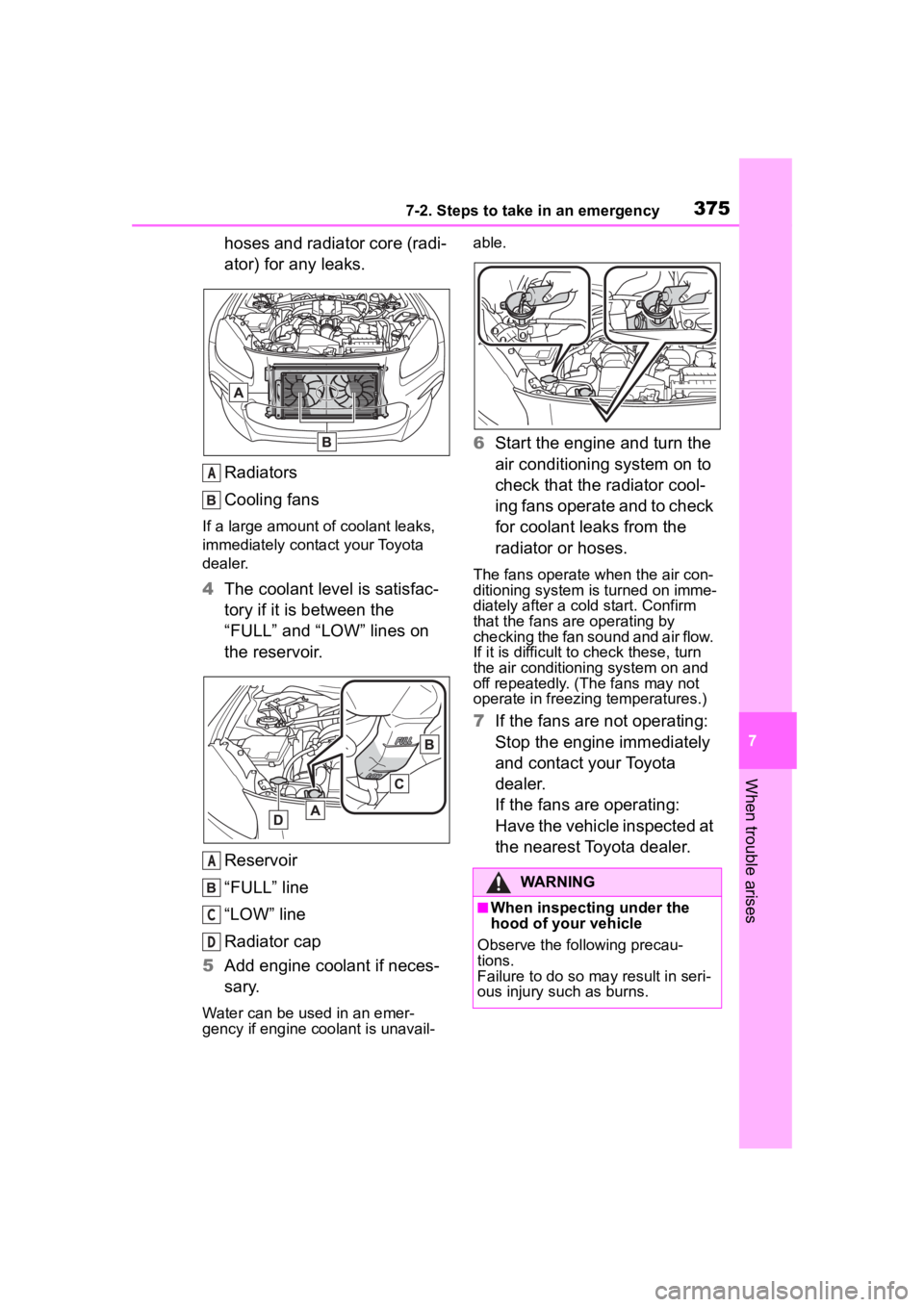
3757-2. Steps to take in an emergency
7
When trouble arises
hoses and radiator core (radi-
ator) for any leaks.
Radiators
Cooling fans
If a large amount of coolant leaks,
immediately contact your Toyota
dealer.
4 The coolant level is satisfac-
tory if it is between the
“FULL” and “LOW” lines on
the reservoir.
Reservoir
“FULL” line
“LOW” line
Radiator cap
5 Add engine coolant if neces-
sary.
Water can be used in an emer-
gency if engine coolant is unavail- able.
6
Start the engine and turn the
air conditioning system on to
check that the radiator cool-
ing fans operate and to check
for coolant leaks from the
radiator or hoses.
The fans operate when the air con-
ditioning system is turned on imme-
diately after a cold start. Confirm
that the fans are operating by
checking the fan sound and air flow.
If it is difficult to check these, turn
the air conditioning system on and
off repeatedly. (The fans may not
operate in freezing temperatures.)
7If the fans are not operating:
Stop the engine immediately
and contact your Toyota
dealer.
If the fans are operating:
Have the vehicle inspected at
the nearest Toyota dealer.
A
A
C
D
WARNING
■When inspecting under the
hood of your vehicle
Observe the following precau-
tions.
Failure to do so may result in seri-
ous injury such as burns.
Page 376 of 449
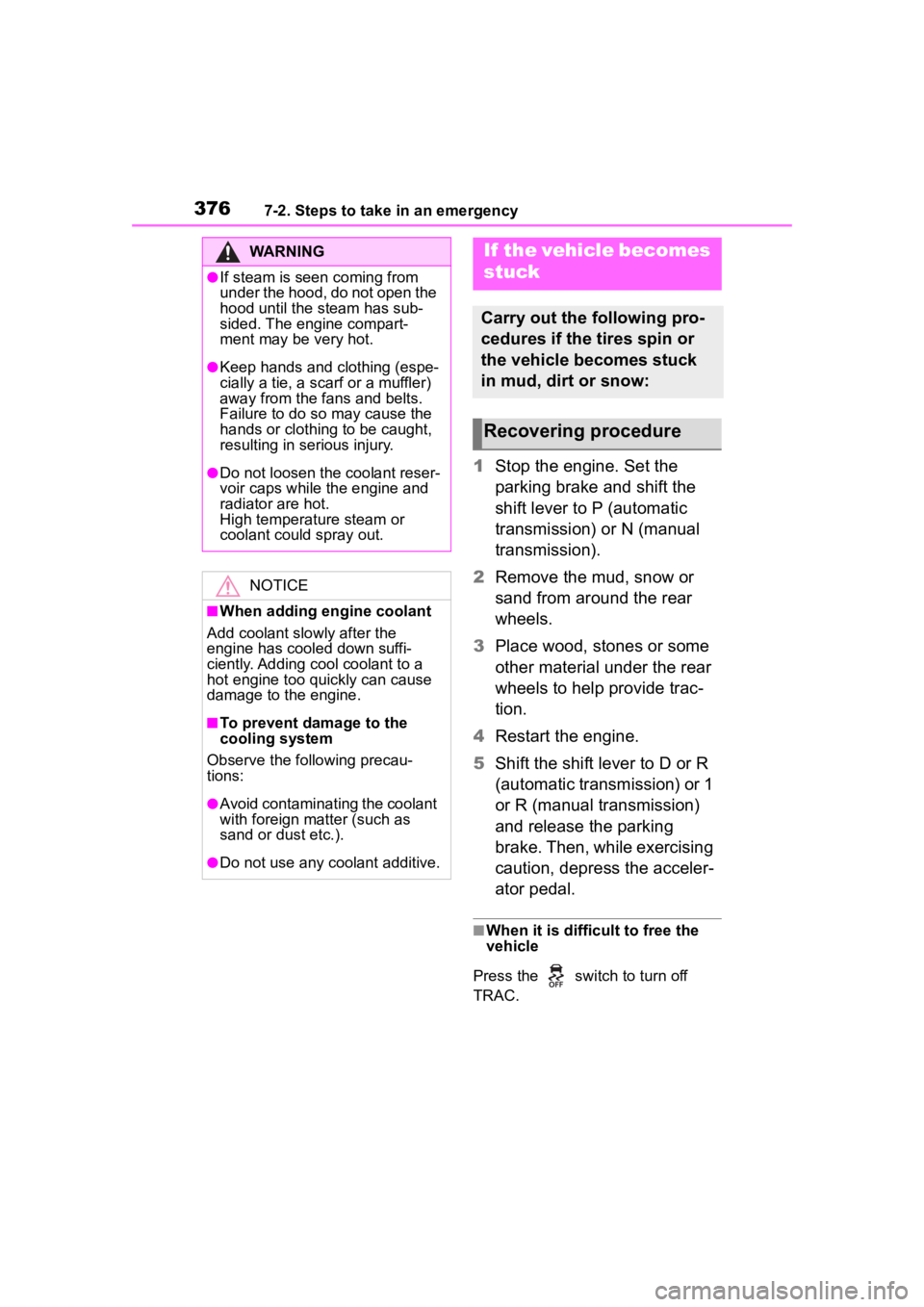
3767-2. Steps to take in an emergency
1Stop the engine. Set the
parking brake and shift the
shift lever to P (automatic
transmission) or N (manual
transmission).
2 Remove the mud, snow or
sand from around the rear
wheels.
3 Place wood, stones or some
other material under the rear
wheels to help provide trac-
tion.
4 Restart the engine.
5 Shift the shift lever to D or R
(automatic transmission) or 1
or R (manual transmission)
and release the parking
brake. Then, while exercising
caution, depress the acceler-
ator pedal.
■When it is difficult to free the
vehicle
Press the switch to turn off
TRAC.
WARNING
●If steam is seen coming from
under the hood, do not open the
hood until the steam has sub-
sided. The engine compart-
ment may be very hot.
●Keep hands and clothing (espe-
cially a tie, a scarf or a muffler)
away from the fans and belts.
Failure to do so m ay cause the
hands or clothing to be caught,
resulting in serious injury.
●Do not loosen the coolant reser-
voir caps while the engine and
radiator are hot.
High temperature steam or
coolant could spray out.
NOTICE
■When adding engine coolant
Add coolant slowly after the
engine has cooled down suffi-
ciently. Adding cool coolant to a
hot engine too quickly can cause
damage to the engine.
■To prevent damage to the
cooling system
Observe the following precau-
tions:
●Avoid contaminating the coolant
with foreign matter (such as
sand or dust etc.).
●Do not use any coolant additive.
If the vehicle becomes
stuck
Carry out the following pro-
cedures if the tires spin or
the vehicle becomes stuck
in mud, dirt or snow:
Recovering procedure
Page 377 of 449
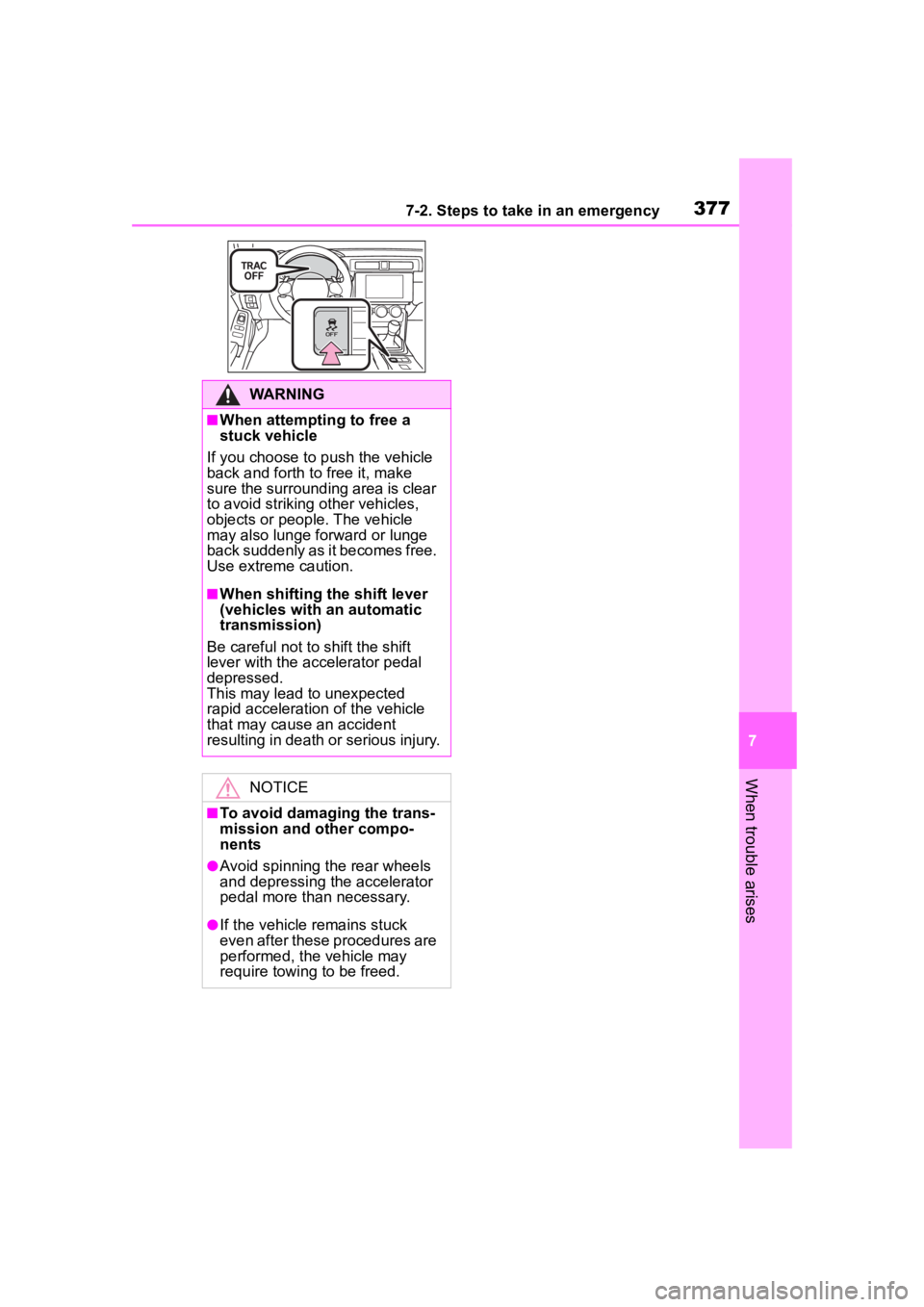
3777-2. Steps to take in an emergency
7
When trouble arises
WARNING
■When attempting to free a
stuck vehicle
If you choose to push the vehicle
back and forth to free it, make
sure the surrounding area is clear
to avoid striking other vehicles,
objects or people. The vehicle
may also lunge forward or lunge
back suddenly as it becomes free.
Use extreme caution.
■When shifting the shift lever
(vehicles with an automatic
transmission)
Be careful not to shift the shift
lever with the ac celerator pedal
depressed.
This may lead to unexpected
rapid acceleration of the vehicle
that may cause an accident
resulting in death or serious injury.
NOTICE
■To avoid damaging the trans-
mission and other compo-
nents
●Avoid spinning the rear wheels
and depressing the accelerator
pedal more than necessary.
●If the vehicle remains stuck
even after these procedures are
performed, the vehicle may
require towing to be freed.
Page 378 of 449

3787-2. Steps to take in an emergency
Page 379 of 449
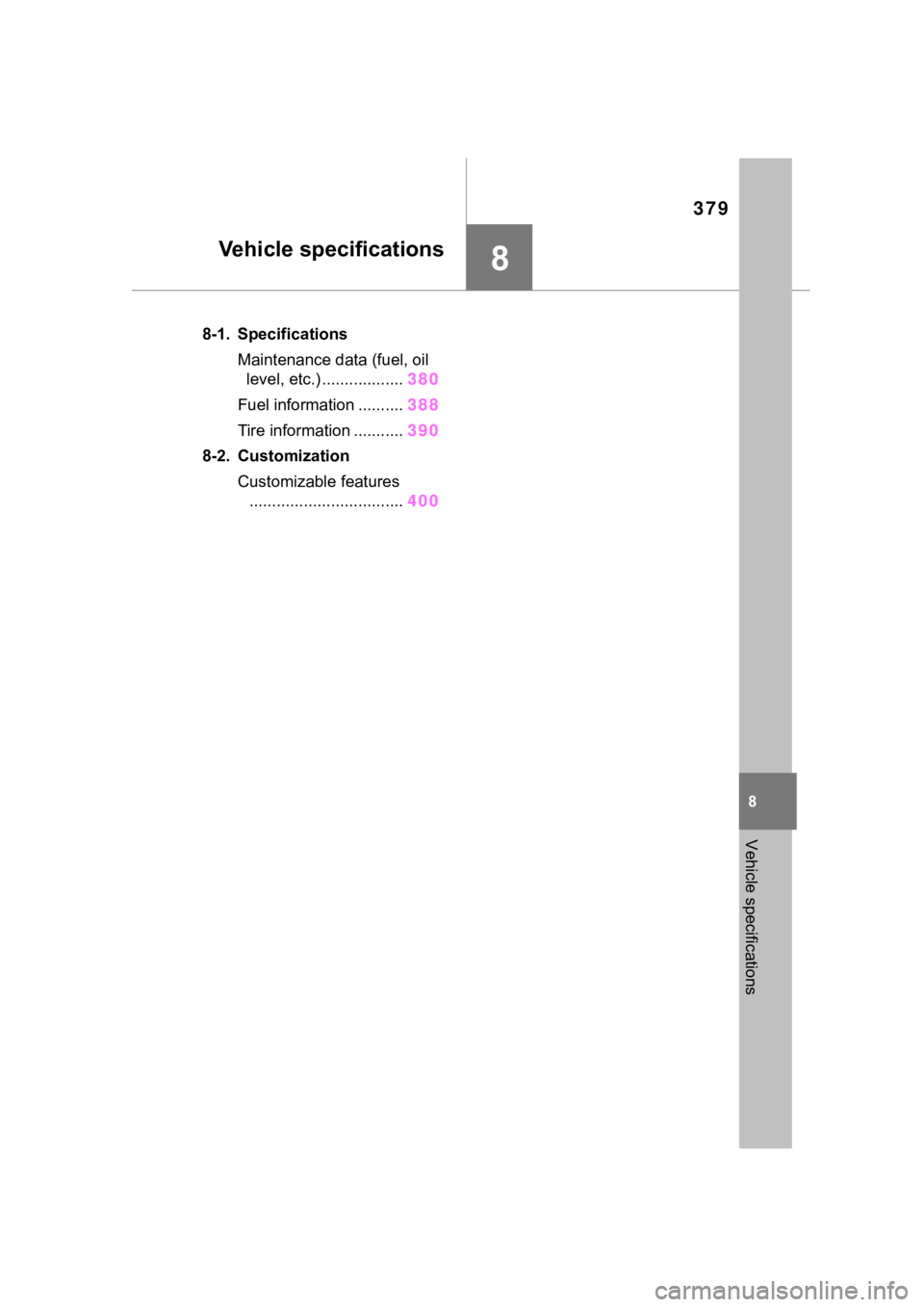
379
8
8
Vehicle specifications
Vehicle specifications
.8-1. SpecificationsMaintenance data (fuel, oil level, etc.) .................. 380
Fuel information .......... 388
Tire information ........... 390
8-2. Customization Customizable features.................................. 400
Page 380 of 449
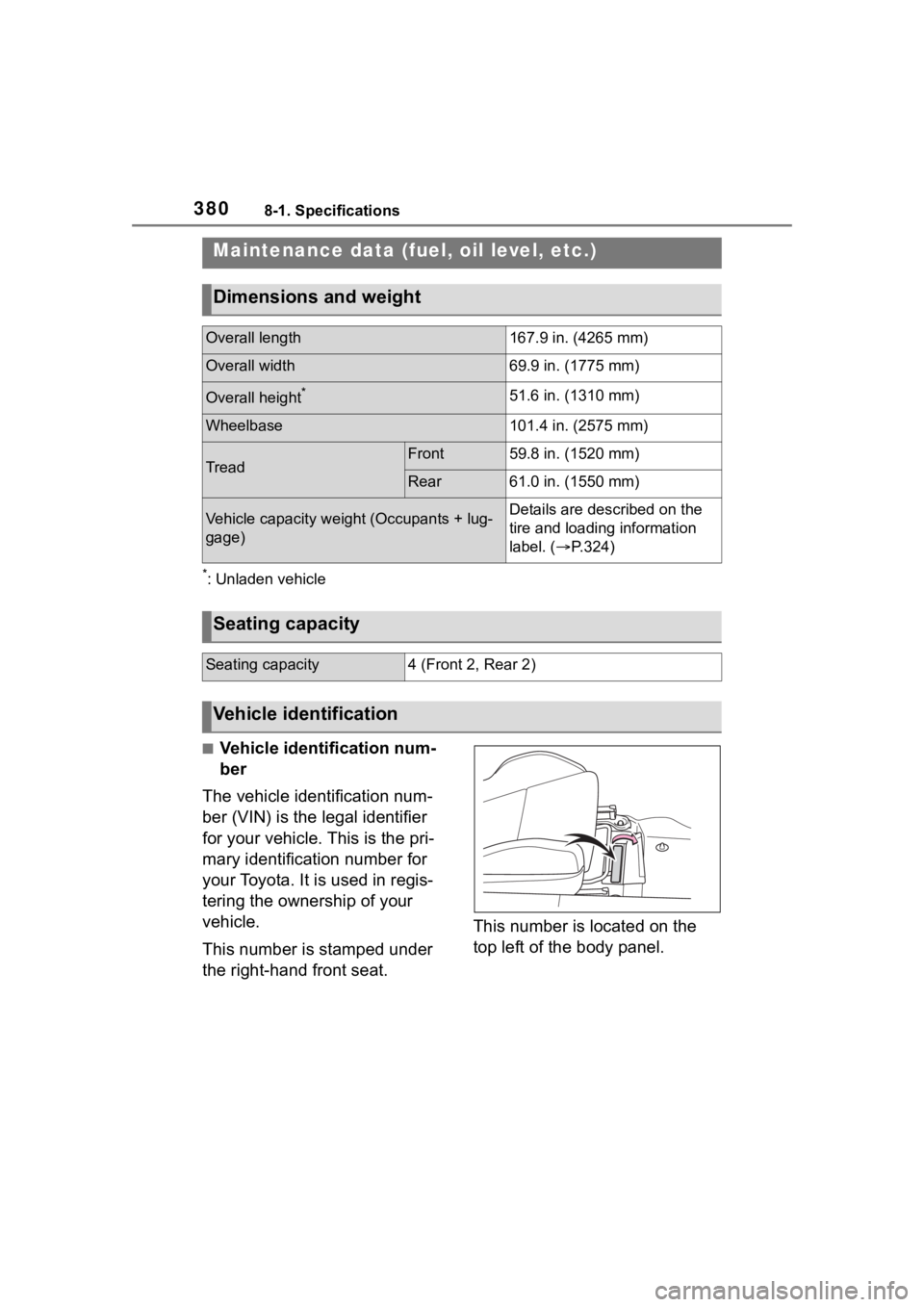
3808-1. Specifications
8-1.Specifications
*: Unladen vehicle
■Vehicle identification num-
ber
The vehicle identification num-
ber (VIN) is the legal identifier
for your vehicle. This is the pri-
mary identification number for
your Toyota. It is used in regis-
tering the ownership of your
vehicle.
This number is stamped under
the right-hand front seat. This number is located on the
top left of the body panel.
Maintenance data (fuel, oil level, etc.)
Dimensions and weight
Overall length167.9 in. (4265 mm)
Overall width69.9 in. (1775 mm)
Overall height*51.6 in. (1310 mm)
Wheelbase101.4 in. (2575 mm)
TreadFront59.8 in. (1520 mm)
Rear61.0 in. (1550 mm)
Vehicle capacity weight (Occupants + lug-
gage)Details are described on the
tire and loading information
label. (
P.324)
Seating capacity
Seating capacity4 (Front 2, Rear 2)
Vehicle identification